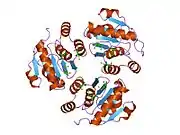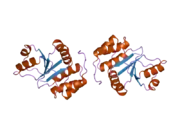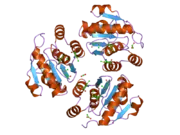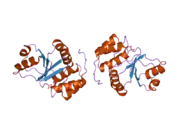| PTP4A1 | |||||||||||||||||||||||||||||||||||||||||||||||||||
|---|---|---|---|---|---|---|---|---|---|---|---|---|---|---|---|---|---|---|---|---|---|---|---|---|---|---|---|---|---|---|---|---|---|---|---|---|---|---|---|---|---|---|---|---|---|---|---|---|---|---|---|
 | |||||||||||||||||||||||||||||||||||||||||||||||||||
| |||||||||||||||||||||||||||||||||||||||||||||||||||
| Identifiers | |||||||||||||||||||||||||||||||||||||||||||||||||||
| Aliases | PTP4A1, HH72, PRL-1, PRL1, PTP(CAAX1), PTPCAAX1, protein tyrosine phosphatase type IVA, member 1, protein tyrosine phosphatase 4A1 | ||||||||||||||||||||||||||||||||||||||||||||||||||
| External IDs | OMIM: 601585 MGI: 1277096 HomoloGene: 2587 GeneCards: PTP4A1 | ||||||||||||||||||||||||||||||||||||||||||||||||||
| |||||||||||||||||||||||||||||||||||||||||||||||||||
| |||||||||||||||||||||||||||||||||||||||||||||||||||
| |||||||||||||||||||||||||||||||||||||||||||||||||||
| |||||||||||||||||||||||||||||||||||||||||||||||||||
| Wikidata | |||||||||||||||||||||||||||||||||||||||||||||||||||
| |||||||||||||||||||||||||||||||||||||||||||||||||||
Protein tyrosine phosphatase type IVA 1 is an enzyme that in humans is encoded by the PTP4A1 gene.[4][5]
The protein encoded by this gene belongs to a small class of prenylated protein tyrosine phosphatases (PTPs), which contains a PTP domain and a characteristic C-terminal prenylation motif. PTPs are cell signaling molecules that play regulatory roles in a variety of cellular processes. This tyrosine phosphatase is a nuclear protein, but may primarily associate with plasma membrane. The surface membrane association of this protein depends on its C-terminal prenylation. Overexpression of this gene in mammalian cells conferred a transformed phenotype, which implicated its role in the tumorigenesis. Studies in rat suggested that this gene may be an immediate-early gene in mitogen-stimulated cells.[5]
Interactions
References
- 1 2 3 GRCh38: Ensembl release 89: ENSG00000112245 - Ensembl, May 2017
- ↑ "Human PubMed Reference:". National Center for Biotechnology Information, U.S. National Library of Medicine.
- ↑ "Mouse PubMed Reference:". National Center for Biotechnology Information, U.S. National Library of Medicine.
- ↑ Peng Y, Genin A, Spinner NB, Diamond RH, Taub R (Aug 1998). "The gene encoding human nuclear protein tyrosine phosphatase, PRL-1. Cloning, chromosomal localization, and identification of an intron enhancer". J Biol Chem. 273 (27): 17286–95. doi:10.1074/jbc.273.27.17286. PMID 9642300.
- 1 2 "Entrez Gene: PTP4A1 protein tyrosine phosphatase type IVA, member 1".
- ↑ Peters, C S; Liang X; Li S; Kannan S; Peng Y; Taub R; Diamond R H (Apr 2001). "ATF-7, a novel bZIP protein, interacts with the PRL-1 protein-tyrosine phosphatase". J. Biol. Chem. United States. 276 (17): 13718–26. doi:10.1074/jbc.M011562200. ISSN 0021-9258. PMID 11278933.
Further reading
- Cates CA, Michael RL, Stayrook KR, et al. (1997). "Prenylation of oncogenic human PTP(CAAX) protein tyrosine phosphatases". Cancer Lett. 110 (1–2): 49–55. doi:10.1016/S0304-3835(96)04459-X. PMID 9018080.
- Dayton MA, Knobloch TJ (1998). "Multiple phosphotyrosine phosphatase mRNAs are expressed in the human lung fibroblast cell line WI-38". Receptors & Signal Transduction. 7 (4): 241–56. PMID 9633825.
- Tsujimoto H, Nishizuka S, Redpath JL, Stanbridge EJ (1999). "Differential gene expression in tumorigenic and nontumorigenic HeLa x normal human fibroblast hybrid cells". Mol. Carcinog. 26 (4): 298–304. doi:10.1002/(SICI)1098-2744(199912)26:4<298::AID-MC8>3.0.CO;2-M. PMID 10569806. S2CID 21209686.
- Zeng Q, Si X, Horstmann H, et al. (2000). "Prenylation-dependent association of protein-tyrosine phosphatases PRL-1, -2, and -3 with the plasma membrane and the early endosome". J. Biol. Chem. 275 (28): 21444–52. doi:10.1074/jbc.M000453200. PMID 10747914.
- Gjörloff-Wingren A, Saxena M, Han S, et al. (2000). "Subcellular localization of intracellular protein tyrosine phosphatases in T cells". Eur. J. Immunol. 30 (8): 2412–21. doi:10.1002/1521-4141(2000)30:8<2412::AID-IMMU2412>3.0.CO;2-J. PMID 10940933. S2CID 8132613.
- Peters CS, Liang X, Li S, et al. (2001). "ATF-7, a novel bZIP protein, interacts with the PRL-1 protein-tyrosine phosphatase". J. Biol. Chem. 276 (17): 13718–26. doi:10.1074/jbc.M011562200. PMID 11278933.
- Si X, Zeng Q, Ng CH, et al. (2001). "Interaction of farnesylated PRL-2, a protein-tyrosine phosphatase, with the beta-subunit of geranylgeranyltransferase II". J. Biol. Chem. 276 (35): 32875–82. doi:10.1074/jbc.M010400200. PMID 11447212.
- Nicolas G, Fournier CM, Galand C, et al. (2002). "Tyrosine Phosphorylation Regulates Alpha II Spectrin Cleavage by Calpain". Mol. Cell. Biol. 22 (10): 3527–36. doi:10.1128/MCB.22.10.3527-3536.2002. PMC 133798. PMID 11971983.
- Wang J, Kirby CE, Herbst R (2003). "The tyrosine phosphatase PRL-1 localizes to the endoplasmic reticulum and the mitotic spindle and is required for normal mitosis". J. Biol. Chem. 277 (48): 46659–68. doi:10.1074/jbc.M206407200. PMID 12235145.
- Strausberg RL, Feingold EA, Grouse LH, et al. (2003). "Generation and initial analysis of more than 15,000 full-length human and mouse cDNA sequences". Proc. Natl. Acad. Sci. U.S.A. 99 (26): 16899–903. Bibcode:2002PNAS...9916899M. doi:10.1073/pnas.242603899. PMC 139241. PMID 12477932.
- Pathak MK, Dhawan D, Lindner DJ, et al. (2003). "Pentamidine is an inhibitor of PRL phosphatases with anticancer activity". Mol. Cancer Ther. 1 (14): 1255–64. PMID 12516958.
- Zeng Q, Dong JM, Guo K, et al. (2003). "PRL-3 and PRL-1 promote cell migration, invasion, and metastasis". Cancer Res. 63 (11): 2716–22. PMID 12782572.
- Mungall AJ, Palmer SA, Sims SK, et al. (2003). "The DNA sequence and analysis of human chromosome 6". Nature. 425 (6960): 805–11. Bibcode:2003Natur.425..805M. doi:10.1038/nature02055. PMID 14574404.
- Werner SR, Lee PA, DeCamp MW, et al. (2004). "Enhanced cell cycle progression and down regulation of p21(Cip1/Waf1) by PRL tyrosine phosphatases". Cancer Lett. 202 (2): 201–11. doi:10.1016/S0304-3835(03)00517-2. PMID 14643450.
- Gerhard DS, Wagner L, Feingold EA, et al. (2004). "The Status, Quality, and Expansion of the NIH Full-Length cDNA Project: The Mammalian Gene Collection (MGC)". Genome Res. 14 (10B): 2121–7. doi:10.1101/gr.2596504. PMC 528928. PMID 15489334.
- Raghavendra Prasad HS, Qi Z, Srinivasan KN, Gopalakrishnakone P (2005). "Potential effects of tetrodotoxin exposure to human glial cells postulated using microarray approach". Toxicon. 44 (6): 597–608. doi:10.1016/j.toxicon.2004.07.018. PMID 15501285.
- Jeong DG, Kim SJ, Kim JH, et al. (2005). "Trimeric structure of PRL-1 phosphatase reveals an active enzyme conformation and regulation mechanisms". J. Mol. Biol. 345 (2): 401–13. doi:10.1016/j.jmb.2004.10.061. PMID 15571731.
- Sun JP, Wang WQ, Yang H, et al. (2005). "Structure and biochemical properties of PRL-1, a phosphatase implicated in cell growth, differentiation, and tumor invasion". Biochemistry. 44 (36): 12009–21. doi:10.1021/bi0509191. PMID 16142898.
- Radke I, Götte M, Kersting C, et al. (2006). "Expression and prognostic impact of the protein tyrosine phosphatases PRL-1, PRL-2, and PRL-3 in breast cancer". Br. J. Cancer. 95 (3): 347–54. doi:10.1038/sj.bjc.6603261. PMC 2360632. PMID 16832410.









